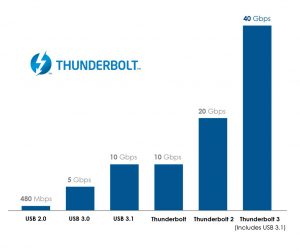People love to joke about disk drives that were once the size of washing machines. Actually, it’s not really a joke, it’s true.
Today, this technology once considered cutting-edge has become obsolete. Large, slow machines have been replaced with super-fast, smart technology that does more than just sit in a corner and collect dust.
Here are 4 computer-based, cutting edge technologies you can’t live without.
- Thunderbolt 3
If you have used a new Macbook Pro, you may have noticed the lack of familiar ports and the addition of a strange, new port called Thunderbolt 3. Like many Apple’s moves, this has created frustration among users who just want to be able to plug in their USB devices without an adapter. 🙂
Thunderbolt 3 is a high-bandwidth technology that operates at 40Gb/second, as opposed to the USB you are used to operating at just 5Gb/second. That means you can plug your smartphone into your Macbook and it will charge much faster than before. Thunderbolt 3 just quickly charge your devices.
Thunderbolt 3 is a superior technology that put standard USB in the dust. With thunderbolt 3, you can copy 14 hours of high definition video in less than a minute. You can also copy 25,000 photos or 10,000 songs in less than a minute.
A solid state hard drive serves the same function as a hard drive with moving parts but, operates differently by storing data on flash memory chips that retain their data, even when there is no power. This is significant because it was not previously easy to get memory chips to retain their data when the power supply was cut off. For example, RAM only stores data temporarily-when the power supply is cut off, all stored data is erased.
Another benefit is they can’t become fragmented, meaning you won’t have to spend nights of pain defragmenting your hard drive. They are also extremely durable.
Now that SSDs have become more popular, more computer manufacturers are offering more new desktop and laptop computers that come with a SSD as a standard option. It means they are becoming more affordable, which is great news for everyone.
3. 3D printing
Technology has advanced to where 3D printing has become a huge trend. 3D printing is achieved with a computer program that allows you to create a 3D model of an object, and feed the data to a machine that constructs the model by compiling layers of melted plastic.
3D printing is not limited to people who can afford experience stuff. You can buy small 3D printers for your home computer that let you design 3D objects, and print them right in your office.
Although 3D printing has fun uses, it also has practical uses. Among the most amazing things printed have been houses, actual train tracks, bridges, cars and even body parts.
In 2014, a 3D printed roadster called the Strati was made onsite at the International Manufacturing Technology Showing Chicago, IL. This 3D printed car was so cool, Popular Mechanics took it for a test drive and gave it a great review.
4. Smart objects for your home.
Smart objects in the home can be luxury, but they can also be useful. When we look at the Numi toilet, for example. This is a toilet that has a motion-activated lid mechanism that allows you to close it without touching anything.
Lock your deadbolt remotely
Another useful smart object is called Lockitron. This device fits over your deadbolt and allows you to operate your deadbolt from smartphone.
The ultimate smart object that seems to outdo any other gadgets is the driverless car. The important question is if driverless cars are safer for pedestrians and cyclists, two road hazards human drivers often have a difficult time seeing. The answer is yes-driverless cars seem to be safer for pedestrians.
In fact, during a test drive, a driverless car was able to notice a pedestrian about to step into the street and the car hesitated to make sure the person did not start crossing the street before turning.
Future of technology is unlimited
If a fully functioning car can be printed from plans created in a computer program, the height of what can be achieved from computers is only limited to what we can create in our minds. As Napoleon said, “whatever the mind can conceive and believe, the mind can achieve.”


















